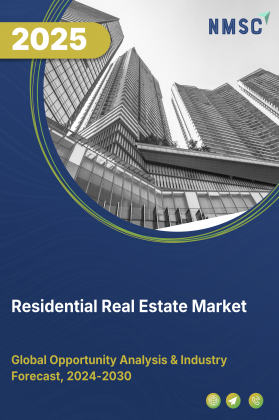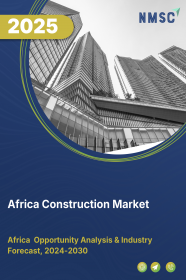
Real Estate Market by Property Size (Small (<500 sq. ft.), Medium (500–2000 sq. ft.), Large (2000+ sq. ft.)), Property Type (Residential, Commercial, Land, Industrial), by Business Type (Buying, Selling, Leasing, Renting and Real Estate Investment), by Ownership (Owner-Occupied Properties, Rental Properties, Co-ownership), and by Property Value (Affordable Housing, and Others) by End User (Individual Buyers, and Others) – Opportunity Analysis and Industry Forecast, 2025–2030.
Industry: Construction & Manufacturing | Publish Date: 24-Sep-2025 | No of Pages: 310 | No. of Tables: 423 | No. of Figures: 352 | Format: PDF | Report Code : CM452
Market Overview
The global Real Estate Market size was valued at USD 9.8 trillion in 2023, and is predicted to reach USD 14.54 trillion by 2030, at a CAGR of 5.8% from 2024 to 2030. Simply put, real estate encompasses a diverse range of tangible properties, including homes, commercial spaces, and land that serve as the foundation of where people live, work, and invest. Residential real estate offers the comfort of homes and apartments, while commercial real estate provides operational spaces for businesses.
Land, on the other hand, holds potential for development or future investment. Real estate is a dynamic market influenced by factors such as the economy and population growth, which impact its value and demand. It plays a vital role in people’s lives and the economy and offers opportunities for homeownership, business establishment, and wealth accumulation, making it a significant area of interest for several individuals and businesses alike.
Accelerated Digitalization of Land Records Enhances Market Transparency and Investment Flow
The global real estate market is increasingly benefiting from the digital transformation of land records. Traditionally, property registration and land title verification processes have been slow, opaque, and prone to disputes, particularly in emerging markets. The adoption of digital land records ensures accuracy, reduces fraud, and minimizes bureaucratic delays. For example, India’s national initiative to digitize all land rights records by 2025 is expected to provide a single source of verified property data, making land acquisition and real estate transactions more transparent and efficient.
This digital shift is also attracting foreign direct investment (FDI) by instilling confidence among investors. With clear property titles and easier legal verification, both domestic and international developers can expedite project launches and reduce transaction risks. Additionally, digitization allows for better monitoring and management of real estate assets, promoting accountability and enhancing the overall market efficiency. The resulting transparency is expected to drive growth across residential, commercial, and industrial real estate segments globally.
Integration of Artificial Intelligence and Automation in Property Management
Artificial Intelligence (AI) and automation are transforming real estate operations, offering significant efficiency gains. AI-powered property management platforms can predict maintenance needs, optimize energy consumption, and provide data-driven insights for tenant engagement. These technologies reduce operational costs for building owners and increase satisfaction for tenants. For example, AI-based monitoring systems can detect anomalies in HVAC systems, lighting, or water usage, allowing proactive intervention and reducing repair expenses.
Meanwhile, automation in construction, such as 3D printing and modular building techniques, is streamlining the development process. Projects can be completed faster, with improved precision and reduced waste. Together, AI and automation are not only enhancing profitability but also promoting sustainable development practices, making properties more appealing to environmentally conscious investors and tenants. These technological advancements are gradually becoming a market standard, supporting long-term growth in the global real estate sector.
Economic Uncertainty and Inflationary Pressures Affecting Real Estate Markets
Global real estate markets are highly sensitive to macroeconomic fluctuations, including inflation, interest rates, and economic uncertainty. Rising interest rates make mortgages and construction financing more expensive, reducing affordability for buyers and slowing new development projects. For instance, in the United States, multifamily construction starts are projected to be significantly below their previous peaks in 2025, even though demand in certain urban regions remains strong. This highlights the dual challenge of high demand but constrained purchasing power.
Furthermore, global geopolitical tensions, volatile foreign exchange rates, and potential recessions can disrupt investment flows, particularly in cross-border transactions. Developers and investors face increased risk in managing financing, project timelines, and cost overruns. These economic pressures compel stakeholders to adopt cautious strategies, which may temporarily slow growth in certain regions, despite long-term demand prospects. Consequently, managing financial risks becomes crucial to sustaining market momentum.
Growth of Real Estate Investment Trusts (REITs) Offering Accessible Investment Opportunities
Real Estate Investment Trusts (REITs) are rapidly expanding as a mechanism to democratize access to the real estate market. REITs allow individual and institutional investors to participate in large-scale real estate projects without directly managing properties. This investment model provides liquidity, regular income through dividends, and exposure to a diversified portfolio of commercial, residential, and industrial assets. In India, REITs and Infrastructure Investment Trusts (InvITs) are expected to experience multi-decade growth, driven by urbanization and infrastructure expansion initiatives.
The increasing popularity of REITs enhances investor confidence and attracts a broader range of participants, including retail investors who previously lacked access to large-scale real estate opportunities. Additionally, these vehicles help developers raise capital efficiently for large projects, supporting new construction and development activities. As a result, REITs not only facilitate investment but also stimulate market growth, making real estate a more inclusive and dynamic asset class worldwide.
Asia-Pacific Dominates the Real Estate Market
The rapid population growth in countries, such as India, China, and Indonesia, is a key driver of real estate market in the Asia-Pacific region. As increasingly more people seek homes and infrastructure, the demand for both residential and commercial properties has been on the rise in this region. This growing demand for properties drives real estate innovation and adaptation and leads to growing emphasis on constructing sustainable and eco-friendly properties, thereby driving the growth of the market in this region.
According to the latest report from the Center of Strategic & International Studies, India has surpassed China as the most populous country in the world in 2023. With this significant increase in population in the region, there is a growing demand for housing and public infrastructure, which drives the expansion of the real estate market in this area.
Moreover, Asia is currently witnessing a substantial transition from rural to urban living, a trend that is fueling the demand for commercial real estate. As more people migrate from rural to urban areas, there is a growing demand for commercial real estate. Businesses and consumers are eyeing these urban hubs, thereby driving the need for office spaces and retail centers. This urbanization-driven demand for commercial properties presents a notable opportunity for real estate developers and investors, which boosts the overall growth of the real estate market in the region.
According to the latest report published by the Central Intelligence Agency, the rate of urbanization in numerous Asian countries, such as China, India, Indonesia, reached 1.78%, 2.33%, and 1.99% respectively. This surge in urbanization, with increasingly more people relocating to cities, has generated substantial demand for real estate properties, thus fueling the growth of the real estate market.
North America is Expected to Show Steady Growth in the Real Estate Market
The increasing government investment in construction and infrastructure development across North American nations, such as the U.S., Canada, and Mexico, is propelling the growth of the real estate market in this region. These substantial investments in a diverse range of projects, including the expansion and enhancement of transportation networks, the revitalization of urban infrastructure, and the development of rural areas boost the demand for real estate properties.
For instance, in May 2023, the U.S. Government announced to invest USD 220 billion in 32,000 infrastructure projects across 4,500 communities across the country. These infrastructure projects, ranging from transportation networks and utility upgrades to community development, drive the demand for real estate properties in this region.
Moreover, the presence of key market players such as Redfin Corporation, Brookfield Asset Management Inc., and Prologis, Inc., plays a significant role in the growth of the real estate market in this region. For instance, in August 2023, Redfin Corporation partnered with Zillow Group Inc. to enhance the home-buying experience for its customers.
In August 2023, Redfin partnered with Zillow to expand home-buying options for its customers who face high demand and limited existing home supply. The partnership aims to enable Redfin's 50 million monthly visitors to access Zillow's extensive selection of new-construction communities, providing more choices.
Competitive Landscape
The market players operating in the real estate market include American Tower Corporation, Prologis, Inc., Crown Castle Inc., Equinix, Inc. (REIT), Brookfield Asset Management Ltd., CBRE Group, Inc., Simon Property Group, Inc., Public Storage, Welltower Inc, Realt Income Corporation, AvalonBay Communities, Inc., VICI Properties, Inc., Vonovia SE, Mitsubishi Estate Co., Ltd., Mitsui Fudosan Co., Ltd., Goodman Group, Sun Hung Kai Properties Limited, Emaar Properties PJSC, Link Real Estate Investment Trust among others. These companies are taking various initiatives such as housing project launches to remain dominant in the market.
For instance, in April 29, 2025, American Tower Corporation (REIT)merican Tower reported stronger-than-expected first-quarter revenue of $2.56 billion, up 2% year-over-year, driven by solid leasing demand in its telecom infrastructure business. AFFO per share was $2.75, slightly down from $2.79 a year prior. The company raised its full-year property revenue forecast to $9.97 billion–$10.12 billion.
Moreover, in July 16, 2025, Prologis, Inc., The company launched over $900 million in new warehouse development projects—nearly triple the $324 million from Q2 2024—with 65% pre-leased before construction began. Full-year development forecast was raised to $2.25 billion–$2.75 billion.
The move caters to the growing importance of logistics real estate and aims to provide companies with an all-encompassing approach to their operational needs, from material handling equipment to sustainable energy solutions.
Real Estate Market Key Segments
By Property Size
-
Small (<500 sq. ft.)
-
Medium (500–2000 sq. ft.)
-
Large (2000+ sq. ft.)
By Property Type
- Residential
-
Apartments/Flats
-
Single-Family Homes
-
Multi-Family Homes
-
Condominiums
-
Townhouses
-
Vacation Homes
-
- Commercial
-
Office Spaces
-
Retail Spaces
-
Co-working Spaces
-
Warehouses
-
-
Land
-
Urban Plots
-
Suburban/Rural Plots
-
-
Industrial
-
Manufacturing Plants
-
Distribution Centers
-
Data Centers
-
By Business Type
-
Buying
-
Selling
-
Leasing
-
Renting
-
Real Estate Investment
-
Direct Property Investment
-
Real Estate Investment Trusts (REITs)
-
By Ownership
-
Owner-Occupied Properties
-
Rental Properties
-
Co-ownership
By Property Value
-
Affordable Housing
-
Luxury Housing
-
Ultra-Luxury Housing
By End User
-
Individual Buyers
-
First-time Homebuyers
-
Repeat Buyers
-
Luxury Buyers
-
Seniors/Retirees
-
-
Business Entities
-
Startups
-
SMEs
-
Large Corporations
-
-
Government
-
Civic Projects
-
Affordable Housing Initiatives
-
-
Institutional Investors
By Region
-
North America
-
The U.S.
-
Canada
-
Mexico
-
-
Europe
-
The U.K.
-
Germany
-
France
-
Italy
-
Spain
-
Denmark
-
Netherlands
-
Finland
-
Sweden
-
Norway
-
Russia
-
Rest of Europe
-
-
Asia-Pacific
-
China
-
Japan
-
India
-
South Korea
-
Australia
-
Indonesia
-
Singapore
-
Taiwan
-
Thailand
-
Rest of Asia-Pacific
-
-
Rest of World
-
Latin America
-
Middle East
-
Africa
-
Key Players
-
American Tower Corporation
-
Prologis, Inc.
-
Crown Castle Inc.
-
Equinix, Inc. (REIT)
-
Brookfield Asset Management Ltd.
-
CBRE Group, Inc.
-
Simon Property Group, Inc.
-
Public Storage
-
Welltower Inc
-
Realt Income Corporation
-
AvalonBay Communities, Inc.
-
VICI Properties, Inc.
-
Vonovia SE
-
Mitsubishi Estate Co., Ltd.
-
Mitsui Fudosan Co., Ltd.
-
Goodman Group
-
Sun Hung Kai Properties Limited
-
Emaar Properties PJSC
-
Link Real Estate Investment Trust
Report Scope and Segmentation
|
Parameters |
Details |
|
Market Size in 2023 |
USD 9.8 trillion |
|
Revenue Forecast in 2030 |
USD 14.54 trillion |
|
Growth Rate |
CAGR of 5.8% from 2024 to 2030 |
|
Analysis Period |
2023–2030 |
|
Base Year Considered |
2023 |
|
Forecast Period |
2024–2030 |
|
Market Size Estimation |
Billion (USD) |
|
Growth Factors |
|
|
Countries Covered |
28 |
|
Companies Profiled |
19 |
|
Market Share |
Available for 10 companies |
|
Customization Scope |
Free customization (equivalent up to 80 working hours of analysts) after purchase. Addition or alteration to country, regional, and segment scope. |
|
Pricing and Purchase Options |
Avail customized purchase options to meet your exact research needs. |

















 Speak to Our Analyst
Speak to Our Analyst
























